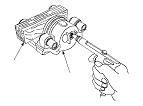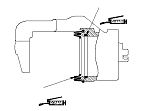Exploded View

|
|
Frequent inhalation of brake pad dust, regardless of material composition, could be hazardous to your health.
|
NOTE:
Upper caliper pin B and lower caliper pin A are different. If these caliper pins are installed in the wrong location, it will cause vibration, uneven or rapid pad wear, and possibly uneven tyre wear.
-
Do not spill brake fluid on the vehicle; it may damage the paint; if brake fluid gets on the paint, wash it off immediately with water.
-
To prevent dripping brake fluid, cover disconnected hose joints with rags or shop towels.
-
Clean all parts in brake fluid and air dry; blow out all passages with compressed air.
-
Before reassembling, check that all parts are free of dirt and other foreign particles.
-
Replace parts with new ones as specified in the illustration.
-
Make sure no dirt or other foreign matter gets in the brake fluid.
-
Make sure no grease or oil gets on the brake discs or the brake pads.
-
When reusing brake pads, always reinstall them in their original positions to prevent loss of braking efficiency.
-
Do not reuse drained brake fluid. Use only clean genuine Honda DOT 3 or DOT 4 Brake Fluid from an unopened container. Using a non-Honda brake fluid can cause corrosion and shorten the life of the system.
-
Coat the piston, the piston seal groove, and the caliper bore with clean brake fluid.
-
Replace all rubber parts with new ones whenever disassembled.
-
After installing the caliper, check the brake hose and line for leaks, interference, and twisting.
-
Make sure not to get any silicone grease on the terminal part of the connectors and switches, especially if you have silicone grease on your hands or gloves.
Disassembly
-
Remove the caliper body.
-
Set the wooden block (A) or several shop towels to the caliper body (B) as shown. Blow out the piston with compressed air gradually, and remove the piston from the caliper body.
NOTE: Do not put the hand into the caliper body because the piston will come out hardly from the caliper body.
|




